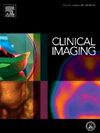对六种不同的 TI-RADS 指南(包括 ACR-/Kwak-/K-/EU-/ATA-/C-TIRADS 指南)的诊断性能进行实际比较
IF 1.8
4区 医学
Q3 RADIOLOGY, NUCLEAR MEDICINE & MEDICAL IMAGING
引用次数: 0
摘要
目的比较美国放射学会甲状腺影像和报告数据系统(ACR-TIRADS)、Kwak-TIRADS、韩国TIRADS(K-TIRADS)、欧洲TIRADS(EU-TIRADS)、美国甲状腺协会(ATA)和中国TIRADS(C-TIRADS)等六种不同的现有指南在区分恶性和良性甲状腺结节(TN)方面的诊断性能。材料和方法在这项单中心研究中,对 2007 年 1 月至 2023 年 9 月期间经手术或细针穿刺活检(FNAB)病理证实的甲状腺结节的超声(US)图像进行了回顾性评估,并根据目前可用的六种不同指南进行了分类。计算了每种指南的曲线下面积(AUC)、灵敏度、特异性、阳性和阴性预测值(分别为 PPV 和 NPV)以及恶性肿瘤漏诊率(MRM)。ACR-TIRADS 的 AUC、灵敏度、特异性、PPV、NPV 和准确度分别为 0.786、99.8 %、27.1 %、31.92 %、99.73 % 和 54.6 %;Kwak-TIRADS 分别为 0.839、97.8 %、42.1 %、36.29 %、98.11 % 和 63.1 %;K-TIRADS 分别为 0.797、97.6 %、41.6 %、36.01 %、84.分别为 0.797、97.6 %、41.6 %、36.01 %、84.85 % 和 62.8 %;EU-TIRADS 分别为 0.766、97.8 %、35.6 %、33.89 %、97.92 % 和 59.1 %;ATA 分别为 0.788、97.5 %、49.8 %、32.86 %、88.16 % 和 64.2 %;C-TIRADS 分别为 0.842、0 %、92.8 %、54.3 %、39.53 %、90.42 % 和 68.8 %。ACR-/Kwak-/K-/EU-/ATA-/C-TIRADS的MRM分别为2.2 %、0.5 %、2.9 %、2.5 %、3.3 %和0.1 %。然而,与其他指南相比,C-TIRADS 的 AUC 最高,MRM 最低。本文章由计算机程序翻译,如有差异,请以英文原文为准。
A real-world comparison of the diagnostic performances of six different TI-RADS guidelines, including ACR-/Kwak-/K-/EU-/ATA-/C-TIRADS
Purpose
To compare the diagnostic performance of six different currently available guidelines including the American College of Radiology Thyroid Imaging and Reporting Data System (ACR-TIRADS), Kwak-TIRADS, Korean TIRADS (K-TIRADS), European TIRADS (EU-TIRADS), American Thyroid Association (ATA) and Chinese TIRADS (C-TIRADS), in differentiating malignant from benign thyroid nodules (TN).
Materials and methods
In this single-center study, between January-2007 and September-2023, ultrasound (US) images of TNs that were pathologically proven either by surgery or by fine needle aspiration biopsy (FNAB), were retrospectively evaluated and categorized according to six different currently available guidelines. Area under curve (AUC), sensitivity, specificity, positive and negative predictive values (PPV and NPV, respectively) and miss rates for malignancy (MRM) were calculated for each guideline.
Results
A total of 829 TNs (n = 234 malignant and n = 595 benign) were included. AUC, sensitivity, specificity, PPV, NPV and accuracy for ACR-TIRADS were 0.786, 99.8 %, 27.1 %, 31.92 %, 99.73 % and 54.6 %, respectively; for Kwak-TIRADS 0.839, 97.8 %, 42.1 %, 36.29 %, 98.11 % and 63.1 %, respectively; for K-TIRADS 0.797, 97.6 %, 41.6 %, 36.01 %, 84.85 % and 62.8, respectively, for EU-TIRADS 0.766, 97.8 %, 35.6 %, 33.89 %, 97.92 % and 59.1 %, respectively, for ATA 0.788, 97.5 %, 49.8 %, 32.86 %, 88.16 % and 64.2 %, respectively and for C-TIRADS 0.842, 0 %, 92.8 %, 54.3 %, 39.53 %, 90.42 %, and 68.8 % respectively. MRM regarding ACR-/Kwak-/K-/EU−/ATA-/C-TIRADS were 2.2 %, 0.5 %, 2.9 %, 2.5 %, 3.3 % and 0.1 %, respectively.
Conclusion
Six different currently available TIRADS guidelines can provide effective differentiation of malignant TNs from benign ones with similar diagnostic performances. However; C-TIRADS offered the highest AUC and the lowest MRM than the other guidelines, in this series.
求助全文
通过发布文献求助,成功后即可免费获取论文全文。
去求助
来源期刊

Clinical Imaging
医学-核医学
CiteScore
4.60
自引率
0.00%
发文量
265
审稿时长
35 days
期刊介绍:
The mission of Clinical Imaging is to publish, in a timely manner, the very best radiology research from the United States and around the world with special attention to the impact of medical imaging on patient care. The journal''s publications cover all imaging modalities, radiology issues related to patients, policy and practice improvements, and clinically-oriented imaging physics and informatics. The journal is a valuable resource for practicing radiologists, radiologists-in-training and other clinicians with an interest in imaging. Papers are carefully peer-reviewed and selected by our experienced subject editors who are leading experts spanning the range of imaging sub-specialties, which include:
-Body Imaging-
Breast Imaging-
Cardiothoracic Imaging-
Imaging Physics and Informatics-
Molecular Imaging and Nuclear Medicine-
Musculoskeletal and Emergency Imaging-
Neuroradiology-
Practice, Policy & Education-
Pediatric Imaging-
Vascular and Interventional Radiology
 求助内容:
求助内容: 应助结果提醒方式:
应助结果提醒方式:


